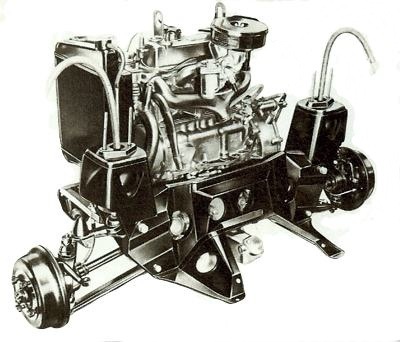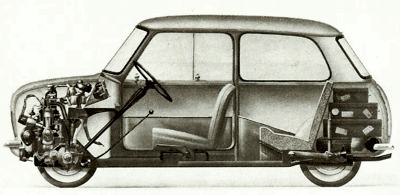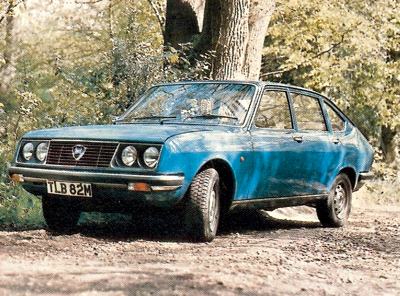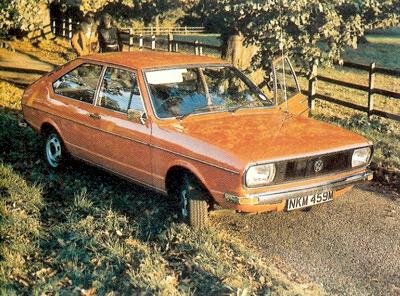The Cugnot Steamer
The idea of pulling a car, rather than pushing it, is actually older than the car itself, the inspiration coming from horse-drawn-vehicle; the Cugnot steamer of 1770 was probably the earliest front-wheel-drive machine. By the 1920s front-wheel drive enjoyed considerable popularity in sports cars such as the Tracta and
Alvis, and even in racing cars - especially in the USA, where the de Dion axle was brilliantly adapted by Miller to serve the driven front wheels of his Indianapolis racers.
The American speedway had been introduced to the idea as early as 1905, and
Barney Oldfield racked up many records with his car. Later in the 1920s Harry Miller met E. L. Cord, president of Auburn, and from that meeting sprang the front-drive
Cord car, a machine that somehow caught all the attention but dropped all the chances. The technical feature that was most significant in the Cord was a new kind of constant-velocity universal joint for the drive shafts. This permitted much greater angular displacement of the wheels for steering than had been possible in earlier front-drive machines, whose poor turning circles had given them bad names.
J. A. Gregoire
The joints previously used were mostly of the common Hooke type, still to be found in the propeller shafts of most front-engined, rear-wheel-driven cars, and when a joint of this type is deflected, the speed of rotation of the output end varies cyclically, the amount of variation depending on the degree of deflection. This caused variation in the speed of rotation of the driven front wheels when steering lock was applied. Complex double joints and other kinds were developed by the Frenchman J. A. Gregoire, progenitor of the Tracta, not to be confused with the American B. F. Gregory, whose front-wheel-drive designs inspired Miller; and it was largely due to Gregoire's perseverance that front-wheel drive eventually became a commercial as well as a technical success in France in the mid 1930s.
The car that achieved this was the Citroen II Legere (also known as the Light 15), which remained in production and in great demand until the mid 1950s. Early versions were not entirely trouble-free: the drive shafts were supposed to be greased every 500 miles. Nevertheless, the car flourished, and doubts about the practicability of front-wheel drive receded. With the major mechanical problems overcome, the way was clear to exploit the system's undoubted advantages. The greatest of these had little or nothing to do with traction, being simply the elimination of the awkward propeller shaft which conveyed the drive from front engine to rear axle in conventional cars. With this shaft gone, the floor could be flat and the seats lower, allowing either more cabin space or a lower roof which, in turn, led to a reduction in frontal area and therefore to lower
aerodynamic drag.
With the shaft gone, there was less temptation on the part of designers to retain the conventional chassis, whose depth was always excusable on the grounds that the floor had to be that much higher anyway to clear the prop-shaft; so there was a strong case for doing away with the chassis and adopting the unitary type of pressed-steel stressed-hull construction gradually making headway among firms devoted to mass production. Another advantage of front-wheel drive was the inherent directional stability it conferred. Such a car is naturally nose-heavy, with its centre of gravity well forward of mid wheelbase. Add to this the degradation of cornering power of the front
tyres because of the camber changes induced by most of the independent suspension systems with which (outside America, at any rate) front-wheel drive was associated, and the further degradation caused by the load on the
tyres - which in those early days were skinny and offered less grip, therby running nearer their limits than today - and the result was a pronounced understeer that the fast but unskilled driver found very forgiving.
Moreover - although the point was seldom appreciated before World War 1 - the forward location of the centre of gravity improved the chances of its remaining ahead of the
aerodynamic centre of pressure, even in a well streamlined body travelling fast, so that the suspension - induced understeer was not overcome at high speeds by
aerodynamically induced oversteer. Front-wheel-drive cars therefore acquired a reputation for exceptional directional stability in cross-winds. Probably the real reason for the Citroen's ability to get a driver round a corner and out of trouble was not that its front wheels were driven but that it was low, stiffly constructed, and very wide in the track, with minimal overhang at each end of a long wheelbase. With these advantages, it could hardly help but be stable and, indeed, a car of such width could have retained them even with rear-wheel drive.
Nevertheless it became accepted that driving the front wheels was a sure way to achieve outstanding roadworthiness and, while the person who thought of a car as simply a means of getting from A to B was easily convinced, those on the racing track soon began to wonder why things did not always work out that way. Sundry small French sports cars competing at Le Mans did not exactly encourage the pursuit of those ideas for full-blooded, front-drive racing cars. Miller himself had said: 'I do not believe that the front-drive car is any faster than the rear-drive type. The reason why it can make better time on the speedways is that it is unnecessary for the drivers to slow down around corners, the skidding of the front-drive type being reduced to a minimum'.

The BMC diagram showing the layout of the Mini. The Mini may have been one of the pioneers of modern day front wheel drive systems, however it used a substantially different arrangement than that used today, with the transmission in the sump..

One of the most famous of the Front Wheel Drives was Sir Alec Issigonis Mini.
 Lancia always made great front wheel drive cars. Lancia always made great front wheel drive cars.

Volkswagen released their first front wheel drive, water cooled model, the K70, in 1971. The front wheel drive system was perfected with the Passat. |
The American Society of Automotive Engineers
Thirty years later theorists were still convinced that the front-drive car could corner faster when accelerating than when decelerating, and was inherently faster round corners than the rear-drive type when the accelerating technique was used correctly. Had they read the annals of the American Society of Automotive Engineers, they would have found that in 1926,
Barney Oldfield was telling them that there was less tendency to skid provided the driver had the courage to keep his foot on the throttle: 'Just prior to the (Indianapolis) 500 Mr Duray demonstrated that, with the foot on the throttle, the car will travel in the direction in which it is pointed. Pete de Paolo demonstrated that, with the foot off the throttle, the car will not travel in the direction in which it is pointed'. Hundreds of racers would be quick to agree.
The real trouble is that it is natural and generally desirable that the preponderance of a car's weight should be over its driving wheels, and when the front wheels are driven by a frontal engine it is unavoidable that this should be so. It may give poor acceleration off the starting line or up a steep hill from standstill, because the weight transference to the rear wheels during acceleration unloads the driving wheels and permits them to spin; but these are problems that seldom beset the ordinary motorist. While the throttle was open and the engine was delivering tractive torque to the front wheels, the
tyres on those wheels would have their cornering power (already reduced by the weight they carried) further depleted by the torque they transmitted.
Relieved of this torque, they would then adopt a smaller slip angle and the existing understeer would be reduced or even completely nullified, to be replaced by some degree of oversteer. The cure that became available as the 1960s progressed was simply bigger and better tyres. Instead of working beyond the peak of the cornering force relationship - when an increase in load would decrease the tyre's cornering power - they could now operate on the upward slope of the curve: in other words, an increase in load would increase cornering power. The side effects of tractive torque would then be proportionally less, while improvements in the side-wall construction of radial-ply
tyres combined with wider wheel rims to reduce lateral compliance - the sideways distortion that varied sharply with changes in stress in earlier tyres. Add to this a great deal of work on the cultivation of roll steer by careful attention to suspension geometry, and the result was that many front-wheel-drive cars were almost entirely free from the basic
handling problems that beset earlier examples.
But there remain some difficulties. A front-drive car has its centre of gravity well forward. With the driver aboard, the situation is little different; but when the driver is joined by three or four passengers, and the luggage boot is fully laden, and the fuel tank (usually in the tail of the car) is full, then the centre of gravity moves a long way towards the rear. In a car as substantial and long and relatively low as the
Citroen DS, the effect may not be very noticeable - and in that particular car it was further masked by self-levelling suspension. But it was in the small car that front-wheel drive proved to offer the strongest commercial attractions, and in a small car the migration of the centre of gravity could have serious consequences. The cornering balance obviously suffers; so does the braking balance, as the distribution of braking effort is arranged so as to prevent premature locking of the rear wheels when the car is running light, braking efficiency will be impaired in the fully laden state.
The Rzeppa Ball-Type Constant-Velocity Universal Joint
The same weight shift will make steep hill starts difficult, and play havoc with the alignment of the headlamp beams. A front-engined rear-driven car generally displays less sensitivity to load because it is more evenly balanced, while a tail-heavy rear-engined four-seater is least affected of all, the rear-seat passengers coming between the engine and the driver and sitting roughly coincident with the centre of gravity. For many years it was held that the rear-engined car was the cheapest to make, because it dispensed with the propeller shaft and it did not demand complex transmission elements as did the front-drive car. The introduction of the Rzeppa ball-type constant-velocity universal joint, and the adoption of the transverse engine configuration in the
BMC Mini, overcame these objections.
It was the
Mini which set new standards for the ratio of habitable to total volumes and thus made the really small car truly practical. As in the case of the Light 15 Citroen, its wide track, low build, and natural disposition of a wheel at each corner endowed it with roadholding and agility that also set new standards; and since that time there has been a steady proselytizing among car designers so that more and more of the world's small cars are driven by their front wheels. In the USA it was one of the Oldsmobile Toronado that was setting the standard in front wheel drive configuration. Road testers of the time found the Toronado surprisingly well-behaved, and some were almost convinced that front-wheel drive had its virtues; and on icy roads there was no doubting them. Only when the power to weight ratio reaches super-sporting levels do the vices begin to predominate.
The vast majority of front-wheel drive vehicles today use a transversely mounted engine with "end-on" mounted transmission, driving the front wheels via driveshafts linked via constant velocity (CV) joints. This configuration was made popular by the
1967 Simca 1100, and the 1969 Fiat 128. Volvo Cars has switched its entire lineup after the 900 series to front wheel drive. Swedish engineers at the company have said that transversely mounted engines allow for more crumple zone area in a head on collision. American auto manufacturers are now shifting larger models (such as the Chrysler 300 and most of the Cadillac lineup) back to rear-wheel drive. There were relatively few rear-wheel drive cars marketed in North America by the early 1990s; Chrysler's car line-up was entirely front-wheel drive by 1990. GM followed suit in 1996 where its B-body line was phased out, where its sports cars (Camaro, Firebird, Corvette) were the only RWDs marketed; by the early 2000s, the Chevrolet Corvette was the only RWD car offered by Chevrolet until the introduction of the Sigma platform.



